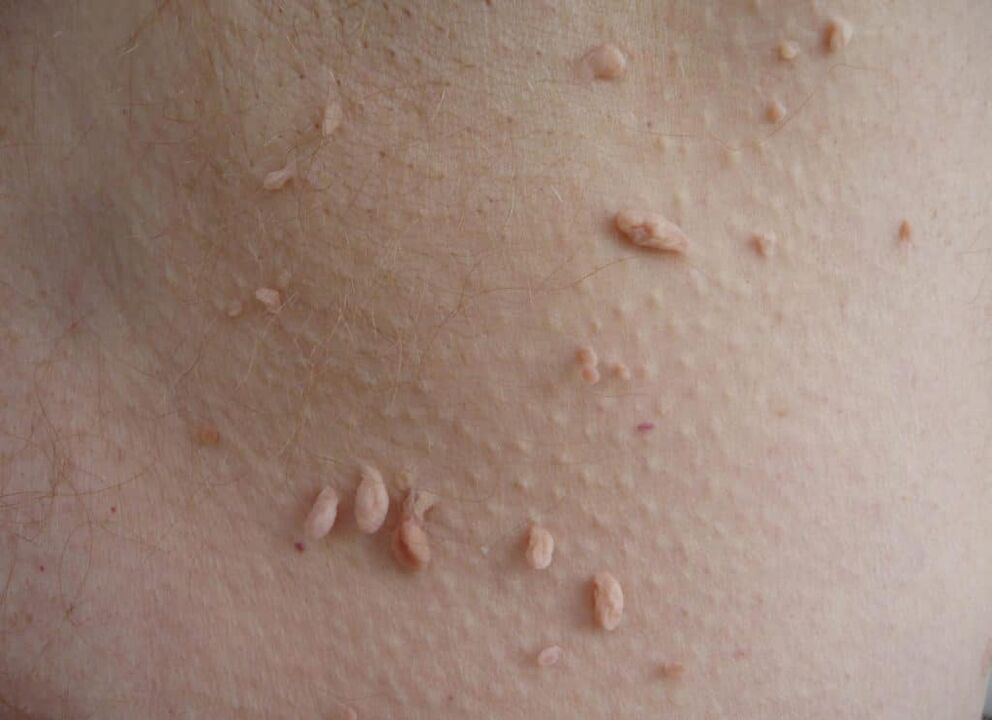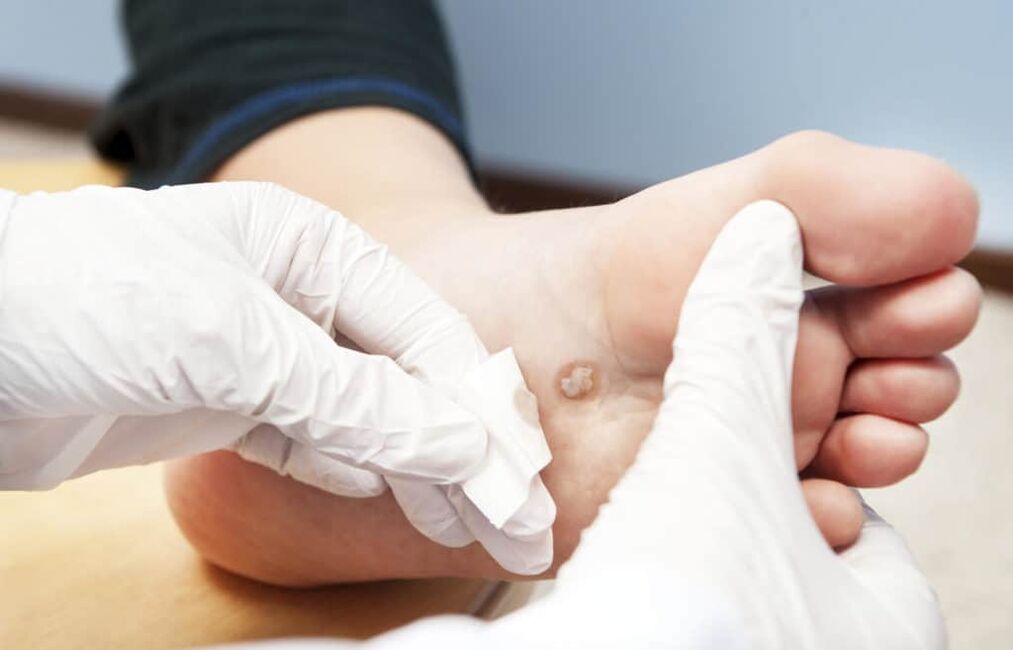Warts are benign skin growths that appear on different parts of the body.They occur in both children and adults and cause a lot of inconvenience to those who get sick with their ugly appearance and discomfort when injured.What causes warts and can they be prevented?
Causes of warts

HPV can be "found" in public baths or saunas, or from manicurists due to poor disinfection of tools.
The main reason for the appearance of warts lies in the human papillomavirus (HPV) infection, which is transmitted through household or sexual contact (the exception is keratomas resulting from age-related skin changes).The pathogen enters the body of a healthy person through skin damaged in one way or another, and provoking factors can be:
- increased activity of the virus in the carrier of the disease;
- a sharp decrease in immunity in a healthy person.
From the moment of infection to the appearance of the first formations, it takes from 14 days to several years - during this time, the virus does not bother the patient at all.HPV activation is mainly due to:
- changes in hormonal levels due to drugs, pregnancy, diseases;
- tension;
- deterioration of the general state of health due to illness;
- prolonged exposure to cold;
- overwork.
Why do warts appear on the body?
Warts (papillomas) on the body appear as a result of contact with the carrier or things of the human papilloma virus.The ways of infection can be different:
- use of the patient's personal belongings - towels, underwear and bed linen, combs, dishes, personal hygiene products and so on;
- touching common objects - railings, door handles, elevator buttons;
- visiting swimming pools, saunas and baths (especially without rubber slippers);
- unprotected sexual contact with an infected person;
- cleaning crowded places;
- self-infection (the appearance of warts on the body is caused by frequent trauma of the maternal formation).
Why do warts appear on the hand?
Warts on the hands and other parts of the body are caused by HPV infection.The cause of the appearance of warty growths is physical contact with an infected person or their belongings (for example, infection can occur as a result of shaking hands).In this case, the following types of warts may develop:
- simple (vulgar)- painless growths with a keratinized surface on the hands and fingers (their size increases over time);
- periungual– simple types that form near the nail;
- apartment (youth)- flat, rounded nodules that appear on the back of the hand and on the inner surface of the limbs below the elbow (usually observed in adolescents, but can also occur in adults).
Why do warts grow on the legs?

The skin of the feet should be taken care of especially carefully, since the virus can enter the body much more easily if the feet tend to sweat.
Warts on the legs are painful growths that can grow.They appear on the heels or feet due to infection with the HPV virus.The causes leading to the development of the disease are as follows:
- reduced immunity;
- the presence of diseases that lead to the deterioration of blood supply to the lower limbs - varicose veins, diabetes mellitus;
- wearing uncomfortable, tight or low-quality (plastic) shoes;
- tension;
- increased sweating of the feet;
- sleep disorders;
- lack of vitamins;
- dry wine.
Why do warts appear on the fingers?
Warts on the fingers appear as a result of direct contact with a person infected with HPV or the objects he uses.This could be holding hands, touching a handrail on the subway, wearing someone else's slippers, etc.As a general rule, vulgar and plantar warts can be transmitted as described.
Why do warts appear on the genitals?
The HPV virus, which causes warts in the genital area, perineum and anus (condylomas), is spread through unprotected sex.Without proper treatment, due to constant trauma, the number of genital warts increases, which in turn leads to the formations becoming cauliflower-like.
How does a wart start to grow?
When activated in the human body, the human papillomavirus attacks the skin cells, resulting in excessive division and tissue proliferation (at this point the wart begins to grow).
Attention!Proper treatment of the pathology at an early stage allows the virus to return to a "dormant" state and prevents further spread of formations throughout the body.
Are warts dangerous?
Warts are benign formations that are not capable of causing serious harm to human health.However, they still need to be managed.This is explained by:
- the high degree of infectivity of the formations and their rapid spread on the skin;
- risk of secondary infections due to accidental damage to growths;
- risk of developing malignant tumors (transformation into cancer);
- risk of infecting others.
Diagnostics

Warts can only be treated under the supervision of a dermatologist.
The diagnosis is made by a dermatologist based on clinical manifestations.Further research, including DNA typing, is rarely needed.The main signs of warts are:
- lack of skin pattern on the surface;
- presence of blackheads (clogged capillaries);
- bleeding from injury.
During the examination, other skin pathologies were excluded.In difficult cases, a biopsy is possible, followed by a histological examination of the wart tissue.
Treatment
Despite the fact that today there are many ways to get rid of warts, none of them eliminate the cause of their appearance - the human papillomavirus.That is why the disease returns again in 30% of cases.
Treatment is needed if the warts:
- grows quickly or itches;
- they are often injured;
- the number of formations is increasing sharply.
Drug therapy
Drug treatment of warts is carried out comprehensively.Patients are prescribed:
- agents that have a chemical effect on formations;
- cytotoxic drugs;
- agents affecting the immune system - interferons.
Folk remedies
Treatment of warts with folk remedies is usually used when they have just started to grow or when a single small formation needs to be removed.In the vast majority of cases, the following recipes are used for this purpose.
- Garlic.Cut a clove of fresh garlic in half and rub one half over the wart.The treatment is carried out twice a day.
- Garlic patch.Cut a plate from the clove of garlic according to the size of the formation, place it on the growth and fix it with plaster.The manipulation is performed before going to bed.Remove the garlic in the morning.
- Garlic paste.Grate the garlic using a grater.Mix one teaspoon of porridge with a similar amount of melted lard and four teaspoons of vinegar.The finished product is placed on a bandage, applied to the surface of the previously steamed formation, covered with polyethylene, fixed with a bandage and wrapped in something warm.
- Garlic flatbread.Grate the garlic.Add acetic acid and flour to the pulp, knead the dough and make a flat cake.In the evening, before going to bed, the cake is applied to the wart, covered with polyethylene and fixed with a plaster.
Other methods

There are other more effective ways to remove warts.These are:
- cryodestruction;
- electrocoagulation;
- laser coagulation;
- surgical excision.
Cryodestruction is a procedure that involves freezing the warts with liquid nitrogen.The material is applied to the surface of the formation using a tampon attached to a wooden stick or a special cryoapplicator.Freezing lasts for 10-30 seconds, after which the growth turns white and dense.After an hour, a blister appears on the skin, which eventually turns into a crust.
Electrocoagulation is the removal of warts using electric current.The formation is cut using a thin loop under high-frequency current, which helps to avoid bleeding and disinfect the tissue.The procedure is performed under local anesthesia.A crust forms at the site of the wart, which falls off after seven days.If cancer is suspected, the cut tissues are sent for histological examination.
Electrocoagulation is based on the cauterization of diseased tissues with electric current, as a result of which the skin formations die.
Laser coagulation involves laser cutting of warts.The formation is removed layer by layer under local anesthesia.A small indentation will remain at the site of the growth, which will heal after a few weeks.
Surgical excision of warts is used to remove large or confluent warts.The growths are excised with a scalpel under local anesthesia.After removal, the edges of the wound are sewn together with a cosmetic suture, and the biological material is sent for histological examination.A thin scar remains at the site of the wart.
These manipulations are performed exclusively in a hospital setting.
What to do if the wart grows after removal?
A relapse of the disease indicates the activation of the human papillomavirus in the body.If the wart appears again, it should be removed, and then measures should be taken to strengthen the immune system.
You can start removing the growth only after visiting the doctor and confirming the benign nature of the wart.Otherwise, removal by traditional methods involves significant health problems.























